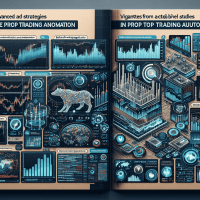Proven Prop Trading Automation: Advanced Strategies for Success
In the world of proprietary trading, automation is no longer a luxury—it’s a necessity. Today, we dive deep into effective prop trading automation solutions that not only streamline operations but also improve decision-making and risk management. This comprehensive guide explores advanced backtesting methodologies, tool comparisons, and real-world case studies to help both budding and experienced traders gain a competitive edge.
Why Prop Trading Automation is Essential
Prop trading automation transforms the way trading desks operate by integrating cutting-edge technology with robust trading strategies. When executed properly, automated systems allow traders to handle more complex strategies more efficiently while reducing human error. With stringent regulatory environments and rapid market changes, prop trading firms require strategies that are both adaptive and resilient.
Automation not only drives efficiency but also provides critical performance insights. Ultimately, prop trading automation helps reduce manual workload, optimize backtesting processes, and enhance risk management practices.

Figure 1: A screenshot of an advanced prop trading automation dashboard showcasing key metrics and performance indicators.
Advanced Backtesting Concepts and Best Practices
Understanding Common Pitfalls
Backtesting is a crucial step in validating trading strategies, but it comes with its own set of challenges, including:
- Overfitting: Creating a model too closely tailored to historical data, which may fail in live environments.
- Survivorship Bias: Ignoring the assets that did not survive the period under study, skewing performance results.
- Look-Ahead Bias: Using data that would not have been available at the time of trading, leading to unrealistic results.
- Data Snooping: Excessive tweaking of a strategy using the same data repeatedly.
Pro Tip: Integrate out-of-sample data and use walk-forward optimization techniques to mitigate these risks. This method recalibrates the strategy periodically to better adapt to evolving market conditions.
Walk-Forward Optimization vs. Traditional Backtesting
Traditional backtesting relies solely on historical data. However, walk-forward optimization involves continuously updating the model parameters as new data is introduced. This provides several advantages:
- Realism: Mimics live market conditions by testing the strategy on unseen data.
- Adaptability: Continual adjustments allow the strategy to stay relevant as market dynamics change.
- Robust Metrics: Helps in identifying true performance improvements rather than overfitting to historical data.
Comparative Analysis of Leading Prop Trading Tools
Automated backtesting requires reliable tools. Here, we analyze and compare three leading platforms: TradingView, MetaTrader 5, and NinjaTrader. Each tool offers unique features suited for both prop trading firms and individual traders.
| Tool | Backtesting Features | Data Quality | Integration Capabilities | Pricing & Free Trial | Prop Firm Suitability |
|---|---|---|---|---|---|
| TradingView | Vectorized backtesting, ease of use, optimization features available | Robust historical data, multi-asset classes, real-time feeds | API access, excellent integration with brokerage systems | Multiple pricing tiers with free basic version | Ideal for both retail traders and small prop firms seeking simplicity |
| MetaTrader 5 | Event-driven backtesting, commission/slippage adjustments, scenario analysis | Deep historical data across Forex and CFDs, real-time data | Widely integrated with various brokers and add-ons | Generally free with brokerage accounts, premium plugins available | Well-suited for high-frequency trading teams and detailed strategy development |
| NinjaTrader | Flexible backtesting environment, automated parameter optimization, report generation | High-quality tick and bar data, broad asset coverage | API support, broker integration, compatibility with analytic tools | Free for advanced charting; fees apply for live trading and add-ons | Scalable for larger prop trading teams needing collaboration features |
These tools differ widely in their capabilities. Advanced prop trading firms may favor NinjaTrader for its robust optimization and scalability, while individual traders might lean toward TradingView for its user-friendly interface.
Real-World Case Studies of Prop Trading Automation
Consider a mid-sized prop firm that implemented automated backtesting and trade execution using MetaTrader 5 and NinjaTrader. They faced challenges such as overfitting and slow iteration times. By adopting walk-forward optimization and automated stress testing, the firm saw tangible improvements:
- A 25% increase in the Sharpe ratio.
- A 15% reduction in maximum drawdown.
- Faster iterations in algorithm refinement, reducing testing cycles by 30%.
Industry Insight: Such case studies underscore the significance of data quality and the right tool selection in achieving consistent prop trading success. Learn more about our detailed prop trading strategies and advanced backtesting methods to further refine your approach.
Integrating Backtesting with Forward Testing for Live Deployment
While backtesting provides critical historical insights, integrating these results into forward testing (or paper trading) is essential for live deployment. Key considerations include:
- Risk Management: Use metrics such as the Sharpe ratio, maximum drawdown, and profit factor to set clear risk limits.
- Real-Time Data Monitoring: Ensure that your system can adapt to live market feeds and adjust strategies dynamically.
- Scenario Analysis: Run stress tests to assess performance during adverse market conditions.
# Example Python code snippet using Backtrader for automated backtesting
import backtrader as bt
class TestStrategy(bt.Strategy):
def __init__(self):
self.sma = bt.indicators.SimpleMovingAverage(self.data.close, period=15)
def next(self):
if self.data.close[0] > self.sma[0]:
self.buy(size=100)
elif self.data.close[0] < self.sma[0]:
self.sell(size=100)
cerebro = bt.Cerebro()
cerebro.addstrategy(TestStrategy)
# Add data feed here (CSV, API, etc.)
# cerebro.adddata(data_feed)
cerebro.run()
cerebro.plot()
This code snippet illustrates the simplicity and power of integrating automated backtesting within a live trading environment. The emphasis should remain on ensuring that live paper trading tests adequately mirror historical backtest conditions.

Figure 2: The forward testing interface showing real-time performance metrics and trade adjustments, reinforcing the critical link between backtesting and live trading.
Essential Checklist for Prop Trading Automation Success
For a more effective prop trading journey, consider the following actionable checklist:
- Data Quality: Ensure historical data is accurate and reliable. Use multiple sources if possible.
- Tool Selection: Compare and choose tools based on comprehensive backtesting features and real-time integration.
- Risk Management: Establish quantitative metrics such as target Sharpe ratios and maximum drawdown limits.
- Walk-Forward Optimization: Regularly re-optimize your model with out-of-sample data.
- Integration Strategy: Bridge the gap between backtesting and live trading with rigorous paper trading tests.
Final Thoughts and Next Steps
The evolution of prop trading automation is driven by the dual demands of technological efficiency and stringent risk controls. With an arsenal of advanced backtesting techniques, carefully selected tools, and an understanding of both historical and real-time data dynamics, traders can significantly elevate their performance. As of October 2023, staying ahead means constantly refining your strategies with real data and advanced methodologies.
For further guidance, download our comprehensive Risk Management Checklist that outlines every step—from data sourcing to live testing integration. This invaluable resource, along with our other content, will empower you to make data-driven decisions in this competitive market.
Remember, the key to successful prop trading lies in continuous improvement and innovation. Start by evaluating your current systems and consider integrating any of the discussed tools and strategies into your trading workflow.
If you found this guide insightful, subscribe to our newsletter for more expert advice, case studies, and practical tips on prop trading automation.
Internal Resources:







